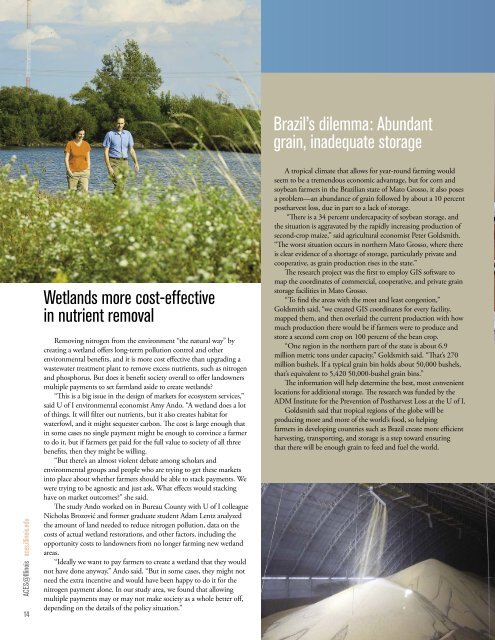t7W0J
t7W0J
t7W0J
Create successful ePaper yourself
Turn your PDF publications into a flip-book with our unique Google optimized e-Paper software.
Brazil’s dilemma: Abundantgrain, inadequate storageACES@Illinois aces.illinois.edu14Wetlands more cost-effectivein nutrient removalRemoving nitrogen from the environment “the natural way” bycreating a wetland offers long-term pollution control and otherenvironmental benefits, and it is more cost effective than upgrading awastewater treatment plant to remove excess nutrients, such as nitrogenand phosphorus. But does it benefit society overall to offer landownersmultiple payments to set farmland aside to create wetlands?“This is a big issue in the design of markets for ecosystem services,”said U of I environmental economist Amy Ando. “A wetland does a lotof things. It will filter out nutrients, but it also creates habitat forwaterfowl, and it might sequester carbon. The cost is large enough thatin some cases no single payment might be enough to convince a farmerto do it, but if farmers get paid for the full value to society of all threebenefits, then they might be willing.“But there’s an almost violent debate among scholars andenvironmental groups and people who are trying to get these marketsinto place about whether farmers should be able to stack payments. Wewere trying to be agnostic and just ask, What effects would stackinghave on market outcomes?” she said.The study Ando worked on in Bureau County with U of I colleagueNicholas Brozović and former graduate student Adam Lentz analyzedthe amount of land needed to reduce nitrogen pollution, data on thecosts of actual wetland restorations, and other factors, including theopportunity costs to landowners from no longer farming new wetlandareas.“Ideally we want to pay farmers to create a wetland that they wouldnot have done anyway,” Ando said. “But in some cases, they might notneed the extra incentive and would have been happy to do it for thenitrogen payment alone. In our study area, we found that allowingmultiple payments may or may not make society as a whole better off,depending on the details of the policy situation.”A tropical climate that allows for year-round farming wouldseem to be a tremendous economic advantage, but for corn andsoybean farmers in the Brazilian state of Mato Grosso, it also posesa problem—an abundance of grain followed by about a 10 percentpostharvest loss, due in part to a lack of storage.“There is a 34 percent undercapacity of soybean storage, andthe situation is aggravated by the rapidly increasing production ofsecond-crop maize,” said agricultural economist Peter Goldsmith.“The worst situation occurs in northern Mato Grosso, where thereis clear evidence of a shortage of storage, particularly private andcooperative, as grain production rises in the state.”The research project was the first to employ GIS software tomap the coordinates of commercial, cooperative, and private grainstorage facilities in Mato Grosso.“To find the areas with the most and least congestion,”Goldsmith said, “we created GIS coordinates for every facility,mapped them, and then overlaid the current production with howmuch production there would be if farmers were to produce andstore a second corn crop on 100 percent of the bean crop.“One region in the northern part of the state is about 6.9million metric tons under capacity,” Goldsmith said. “That’s 270million bushels. If a typical grain bin holds about 50,000 bushels,that’s equivalent to 5,420 50,000-bushel grain bins.”The information will help determine the best, most convenientlocations for additional storage. The research was funded by theADM Institute for the Prevention of Postharvest Loss at the U of I.Goldsmith said that tropical regions of the globe will beproducing more and more of the world’s food, so helpingfarmers in developing countries such as Brazil create more efficientharvesting, transporting, and storage is a step toward ensuringthat there will be enough grain to feed and fuel the world.


